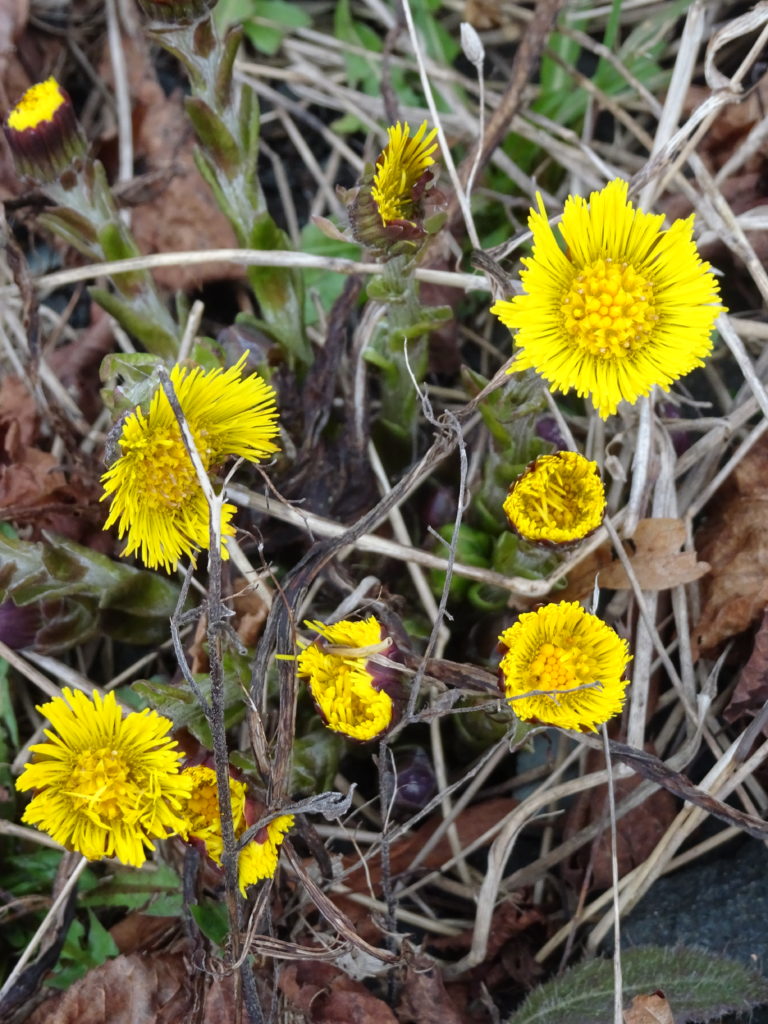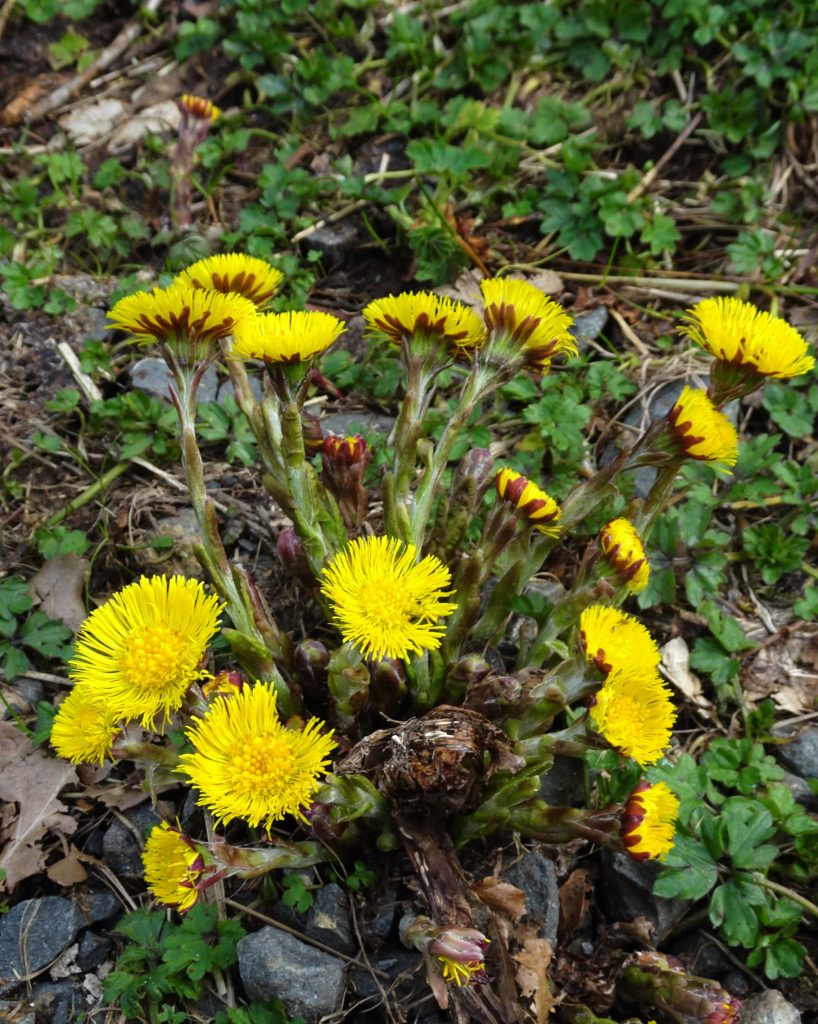Just before Scotland locked down for the first time last year I took a photograph of some coltsfoot (Tussilago farfara) flowering on a piece of waste ground next to an Edinburgh cark park.
Coltsfoot flowers in early spring and it is common throughout Scotland, growing in grassland and waste ground. I’ve even seen it push up through tarmac in Glasgow. The flowers appear before the leaves, the shape of which give the plant its common name. People have found a number of ways to use this ‘common’ plant. Here are a few.

‘Medicine’
The genus name Tussilago is Latin in origin and derives from tussis = a cough and ago = to act on. In his book The Botany of the Eastern Borders (1853) George Johnston, a nineteenth-century doctor in Berwick-upon-Tweed, notes that, ‘A decoction of the Coltsfoot is oftener given than the doctor is aware of, in spring coughs and consumption.’ Much earlier the ancient authors Dioscorides and Pliny both advocated the use of coltsfoot to treat sore throats. Their prescription was to dry the leaves and smoke them.
Coltsfoot is also one of the two thousand plant species that James Sutherland, first attendant of the Edinburgh Physic Garden and first Professor of Botany in the University of Edinburgh, grew in the garden at Trinity Hospital in 1683.
Johnston also notes that in his time Coltsfoot still retained ‘a place in our most expurgated pharmacopoeias.’ Nowadays, the knowledge that coltsfoot contains compounds that cause liver damage, means that only medically trained herbalists prescribe it.
Coltsfoot rock, a geographically protected confection produced in Blackburn, Lancashire, by Stockley’s Sweets, contains coltsfoot extract, and was originally manufactured to relieve asthma sufferers.
Decoration
In 1927 a small book on floral art called Flowers in the Home was published by A. & C. Black.
The author was from Edinburgh and her name was Menie Watt. Menie was born in Glasgow in 1871 where her father, William C. E. Jamieson was a Church of Scotland minister. The family moved to Edinburgh in 1876 when the congregation of the Tron Parish called William to be their minister. Sadly, his ministry in central Edinburgh lasted for only five years, and his widow Jessie Archibald, was left to bring up their family of Menie, John Robert and Jessie. In this task Jessie was helped by her brothers, who were farmers in the Parish of Stow, Midlothian. Menie’s uncles had a well-stocked library of natural history books and her uncle John was also a knowledgeable field botanist.
On 7 June 1899 Menie married James Watt (1863-1945) a young lawyer. As well as building a professional career, James studied mathematics, statistics, geography and meteorology. In 1911 he was elected a Fellow of the Royal Society of Edinburgh and from 1926-1944 he served on the Council of the RSE in various capacities.
Menie herself was an accomplished plantswoman and in 1911 was elected a member of the Royal Caledonian Horticultural Society. In 1936 she was elected a Fellow of the Linnean Society.
There was also a quiet philanthropic side to James and Menie’s life. They both gave strong support to the work of the Edinburgh University Settlement: a project which sought to engage university students and staff in practical social work in Edinburgh’s Old Town.
In fact, Menie’s book was published to raise funds for the Edinburgh University Settlement. In the book she jots down her thoughts on floral art in a conversational style which shows her dry humour and practical mind. Perhaps childhood experiences of making economies, coloured her writing. For example Menie used coltsfoot in her floral room decorating, not something you would expect to find in an Edinburgh sitting or dining room.
I wonder if Menie had read Virginia Woolf’s novel Mrs Dalloway (1925), as I was reminded of the title character’s visit to a high-class London florist, when reading Menie’s observation that the notes in her book “will be of no interest to, and are not intended for, those who can go to say, a Bond Street flower shop with patterns of what they are going to wear, and have the dinner-table flowers worked out from that starting point.’ Menie goes on to drily observe, ‘If such people be not ‘the salt of the earth,’ they are at least a ‘dreepin roast’ to the commercial florist.’ Poor Clarissa Dalloway, maybe some members of the social circle she represented, wouldn’t agree with Menie’s comment about them, that ‘I doubt if they would regard with anything but pity the bowl of planted coltsfoot on my dinner table.’ To reinforce her appreciation of simple coltsfoot Menie reproduces the bowl of coltsfoot as a black and white photographic plate in her book.
When Menie died in December 1957, her friend Dr Harold R. Fletcher, Regius Keeper of the RBGE, composed an obituary notice which appeared in the Proceedings of the Linnean Society. Dr. Fletcher calls Menie a ‘staunch supporter of the Royal Botanic Garden’ and notes that in her latter years she made regular visits to the RBGE by taxi from her home in Edinburgh’s Morningside. In the obituary Dr. Fletcher’s recalls Menie’s earlier garden at Craiglockhart House, which gave ‘scope for her ideas’ as ‘a considerable landscape artist.’
It is neither necessary or desirable to believe that every flower is suited for house decoration; but a great deal more use can be made of much that is often despised or disregarded.
menie watt
Poetry
Quite soon after the publication of Flowers in the Home a student from Shetland arrived in Edinburgh. His name was Thomas Alexander Robertson – to family and friends Alex or Tammy Alex. Graduating M.A. in 1932, his financial position meant that he had to pass over an opportunity to take up postgraduate studies at Oxford University. Instead he undertook teacher training, and for over thirty years he taught history and English in Lerwick Central Public School.
In his free time he wrote poetry in English and Shetland dialect. He used the pen name ‘Vagaland.’
T. A. Robertson’s interest in the natural world started in childhood. Flowers feature in many of his poems; some of which he titled with Shetland dialect flower names. Among these is one called ‘Tuslag’. It can be seen how this Shetland dialect name name nods back to the scientific name of the coltsfoot. Here is the poem reproduced with permission from Shetland Archives who hold the copyright.
TUSLAG
Wi da lentenin days ida first o da Voar Da Mairch wind comes agyin ta da door At da black frost stekkit wi bolts an bars, An reesles him oppen apo da harrs. We wait, whin da door is oppen wide, Fir life ta come ta da world ootside. Ee day, wi a glöd atween da shooers, We see da first o da Tuslag flooers. Whaar last year's girse lies bleached an dowed Dae sheen laek a nevfoo o yallow gowd. Whin we see dem apo da eart we kyin At da Voar is here wi his arles agyin. Dey're a sign ta men at da Voar can gie Plenty ta dem at'll earn dir fee Be da toil o dir haands an da sweat o dir broo Wi kishie, an spade, an harrow, an ploo. Whin dey're kyerried an borrowed an spread an shölled An delled da leys an harrowed da möld, Dey can say at last, "We're döne wir best; Lord send göd wadder ta do da rest. "Dey'll be mael an taaties, an maet fir kye, Ta pey fir wark, an we'll get firbye, As da year gengs on wi da sun an shooers, Da colour an scent o a million flooers."
Voar - seed-time, Spring agyin - again stekkit - closed tightly reesles - wrestles apo - upon harrs - hinges wirld - world glöd - glow, period of bright sun between rain showers shooer - shower Tuslag - coltsfoot flooer - flower whaar - where girse - grass dowed - faded dey - they sheen - shine laek - like nevfoo - handful yallow - yellow gowd - gold kyin - know arles - token payment, payment that confirms a contract dir - their broo - brow kishie - straw basket for carrying peats ploo - plough kyerry - carry shöll - shovel leys - fallow land möld - earth, soil göd wadder - good weather mael - meal taaties - potatoes maet - food kye - cattle pey - pay wark - work firbye - besides, in addition geng - go
To end here is another photograph of this ‘common’ flower, taken early last month.


Keith Gooderham
In our house in Scarborough my mother regularly used coltsfoot to make cleat wine each spring, https://traditional-yorkshire-recipes.info/2018/12/30/cleat-wine/